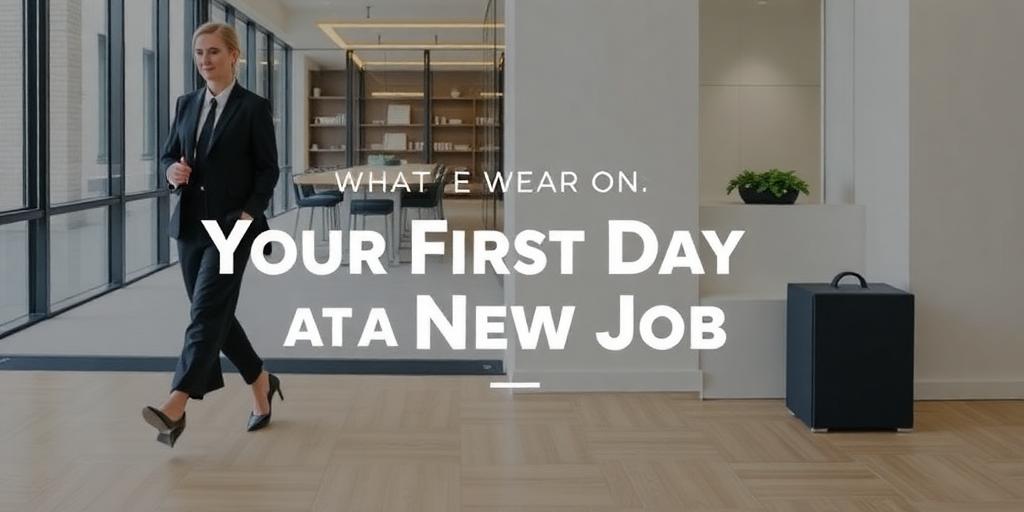First Impressions Matter: Mastering Your First Day Wardrobe
Your first day at a new job is a pivotal moment. Beyond showcasing your skills and enthusiasm, you're also presenting a visual representation of yourself to your new colleagues. The right outfit can project confidence, competence, and respect for the company culture. This guide provides a comprehensive breakdown of how to select appropriate attire, ensuring you make a stellar first impression.
Understanding the Company Culture
Before diving into specific outfit choices, it's crucial to understand the company's dress code. Researching this beforehand can prevent any missteps. Consider the following:
- Formal/Corporate: Typically found in finance, law, and consulting, this environment calls for traditional business attire. Think suits, dress shirts, and classic accessories.
- Business Casual: A prevalent dress code that balances professionalism and comfort. Options include collared shirts, chinos, and blazers. Avoid overly casual items like jeans and sneakers unless explicitly permitted.
- Casual: Common in tech startups or creative agencies, this allows for more relaxed clothing. However, maintain a level of presentability. Clean jeans, stylish tops, and comfortable shoes are acceptable. Avoid anything sloppy or unprofessional.
- Industry-Specific: Some industries, like healthcare, may have specific dress codes for safety and hygiene reasons. Adhere strictly to these guidelines.
Pro Tip: If unsure, err on the side of caution and dress slightly more formally than you anticipate. It's always better to be slightly overdressed than underdressed on your first day.
Curating Your Outfit: Key Considerations
Once you understand the company culture, focus on these key elements when selecting your outfit:
1. Fit and Comfort:
- Ensure your clothes fit well. Avoid anything too tight or too loose, as this can appear unprofessional and be uncomfortable.
- Prioritize comfort, especially with shoes. You'll likely be on your feet for a significant portion of the day, so choose footwear that won't cause discomfort.
2. Color Palette:
- Opt for neutral and classic colors like navy, gray, black, and white. These colors convey professionalism and are easy to coordinate.
- Incorporate subtle pops of color through accessories like scarves or ties to add personality without being distracting.
3. Fabric Choice:
- Select fabrics that are appropriate for the season and climate. Lightweight and breathable fabrics like cotton or linen are ideal for warmer weather, while wool or heavier blends work well in cooler temperatures.
- Avoid fabrics that wrinkle easily, as you want to maintain a polished appearance throughout the day.
4. Accessories:
- Keep accessories minimal and tasteful. A classic watch, simple jewelry, and a professional-looking bag can complement your outfit without being overwhelming.
- Ensure your accessories are clean and in good condition.
5. Grooming:
- Pay close attention to personal grooming. A neat haircut, clean nails, and a fresh scent can significantly enhance your overall appearance.
- Avoid strong perfumes or colognes, as they can be distracting or irritating to others.
Outfit Examples for Different Work Environments
To provide practical guidance, here are a few outfit examples tailored to various work environments:
Formal/Corporate:
- Men: A well-fitted suit in navy or gray, a crisp white dress shirt, a conservative tie, and polished leather shoes.
- Women: A tailored suit or a classic dress with a blazer, closed-toe heels, and minimal jewelry.
Business Casual:
- Men: Chinos or dress pants, a collared shirt (button-down or polo), a blazer or sweater, and loafers or dress shoes.
- Women: Dress pants or a skirt, a blouse or sweater, a blazer or cardigan, and flats or low heels.
Casual:
- Men: Dark-wash jeans or chinos, a stylish t-shirt or button-down shirt, a casual jacket or sweater, and clean sneakers or boots.
- Women: Dark-wash jeans or a casual skirt, a comfortable top, a cardigan or denim jacket, and flats or sneakers.
Avoiding Common Mistakes
To ensure your first-day outfit is a success, avoid these common pitfalls:
- Wearing Clothes That Are Too Revealing: Maintain a professional image by avoiding overly short skirts, low-cut tops, or sheer clothing.
- Ignoring the Dress Code: Failing to research the company's dress code can lead to an awkward first impression.
- Wearing Uncomfortable Shoes: Choose footwear that is both stylish and comfortable to avoid discomfort throughout the day.
- Overdoing Accessories: Keep accessories minimal and tasteful to avoid being distracting.
- Wearing Wrinkled or Stained Clothing: Ensure your clothes are clean, ironed, and in good condition.
Final Thoughts
Your first-day outfit is an opportunity to make a positive and lasting impression. By understanding the company culture, selecting appropriate attire, and paying attention to detail, you can project confidence, competence, and professionalism. Remember, when you look your best, you feel your best – and that confidence can contribute significantly to a successful start at your new job.









